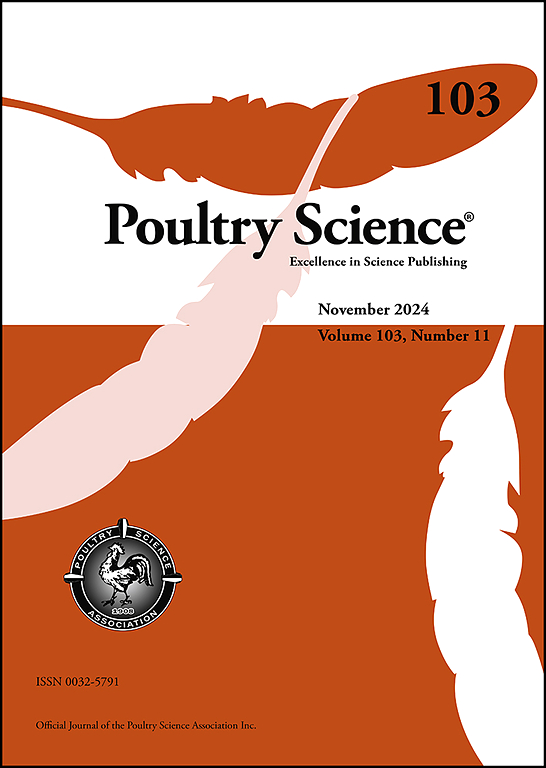清远鹧鸪鸡和科布肉鸡肉质差异的研究:基于多组学分析的见解。
IF 3.8
1区 农林科学
Q1 AGRICULTURE, DAIRY & ANIMAL SCIENCE
引用次数: 0
摘要
以前,动物育种优先考虑提高关键经济性状以提高生产效率,导致肉品质逐渐差异。然而,影响肉质的遗传因素仍不清楚。为了确定影响肉质的关键遗传途径,中国黄羽鸡(清远鹧鸪鸡,QPC;雌性,n=10)和商品肉鸡(科布肉鸡,CB;雌性,n=10)通过代谢组学、蛋白质组学和磷蛋白质组学测序来评估肉质。结果表明:QPC的pH值(93.12%)、剪切力(81.46%)、蒸煮损失(69.29%)、水分含量(93.24%)和肌纤维面积(46.04%)低于CB (p < 0.05),但肉色值(a*(163.65%)和b*(250.27%))、滴漏损失(146.32%)和肌内脂肪含量(382.01%)高于CB (p < 0.05)。代谢组学、蛋白质组学和磷蛋白质组学分析共同进行,揭示了能量代谢策略的显著差异。QPC中糖酵解酶活性较高(ENO1、GAPDH、GPI、PFKM、PKM和TPI1, p < 0.05),而CB中储存了更多的高能磷酸化合物。与QPC相比,CB具有更高的Na+/K+泵蛋白丰度(SCN4A、LOC107051305、ATP1B4、ATP12A、ATP1A1和ATP1A2, p < 0.05)、磷酸化(ATP1A2- ser662, p < 0.05)和Ca2+通道蛋白丰度(ATP2B4、SRL、CACNB1、CACNA1S、CACNA2D1、CAMK2G、LOC107050717和TNNC2, p < 0.05)。在QPC中,CAMKII自磷酸化激活下游蛋白并增加Ca2+。上述结果表明,肉芽孢杆菌比肉芽孢杆菌收缩性更强,这对肉芽孢杆菌和肉芽孢杆菌之间的肉质有一定影响。本文章由计算机程序翻译,如有差异,请以英文原文为准。
Exploring variances in meat quality between Qingyuan partridge chicken and Cobb broiler: Insights from combined multi-omics analysis
Previously, animal breeding prioritized enhancing key economic traits to improve production efficiency, leading to a gradual difference in meat quality. However, the genetic factors influencing meat quality remain unclear. To identify key genetic pathways contributing to meat quality, native Chinese yellow-feathered chicken (Qingyuan Partridge Chicken, QPC; female, n=10), and commercial chicken broiler (Cobb broiler, CB; female, n=10) were used for meat quality assessment through metabolomics, proteomics, and phosphoproteomics sequencing. The results show that QPC had lower pH (93.12%), shear force (81.46%), cooking loss (69.29%), moisture content (93.24%) and muscle fiber area (46.04%), but higher meat color values (a*(163.65%) and b*(250.27%)), drip loss (146.32%), and intramuscular fat content (382.01%) than CB (p < 0.05). Metabolomic, proteomic, and phosphoproteomic analyses were jointly conducted, revealing significant differences in energy metabolism strategies. Higher glycolytic enzyme activity was observed in QPC (ENO1, GAPDH, GPI, PFKM, PKM, and TPI1, p < 0.05), while more energetic phosphate compounds were stored in CB. CB had higher Na+/K+ Pump protein abundance (SCN4A, LOC107051305, ATP1B4, ATP12A, ATP1A1, and ATP1A2, p < 0.05) and phosphorylation (ATP1A2-Ser662, p < 0.05) and Ca2+ channel protein abundance (ATP2B4, SRL, CACNB1, CACNA1S, CACNA2D1, CAMK2G, LOC107050717 and TNNC2, p < 0.05) than QPC. In QPC, CAMKII autophosphorylation activated downstream protein and increased Ca2+. These results suggest CB is more contractile than QPC, contributing to meat quality between CB and QPC.
求助全文
通过发布文献求助,成功后即可免费获取论文全文。
去求助
来源期刊

Poultry Science
农林科学-奶制品与动物科学
CiteScore
7.60
自引率
15.90%
发文量
0
审稿时长
94 days
期刊介绍:
First self-published in 1921, Poultry Science is an internationally renowned monthly journal, known as the authoritative source for a broad range of poultry information and high-caliber research. The journal plays a pivotal role in the dissemination of preeminent poultry-related knowledge across all disciplines. As of January 2020, Poultry Science will become an Open Access journal with no subscription charges, meaning authors who publish here can make their research immediately, permanently, and freely accessible worldwide while retaining copyright to their work. Papers submitted for publication after October 1, 2019 will be published as Open Access papers.
An international journal, Poultry Science publishes original papers, research notes, symposium papers, and reviews of basic science as applied to poultry. This authoritative source of poultry information is consistently ranked by ISI Impact Factor as one of the top 10 agriculture, dairy and animal science journals to deliver high-caliber research. Currently it is the highest-ranked (by Impact Factor and Eigenfactor) journal dedicated to publishing poultry research. Subject areas include breeding, genetics, education, production, management, environment, health, behavior, welfare, immunology, molecular biology, metabolism, nutrition, physiology, reproduction, processing, and products.
 求助内容:
求助内容: 应助结果提醒方式:
应助结果提醒方式:


